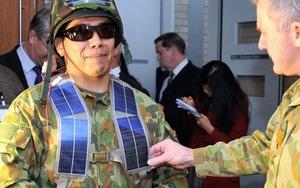In the trenchesDay of "solar" soldiers nears
Researches develop wearable light-weight solar panels which will allow soldiers to generate power in the field and reduce the need for batteries for their electronic devices; they will also establish a power supply that keeps electronic devices operational throughout the duration of missions

Flexible panels allow power generation in the field // Source: ubergizmo.com
Wearable light-weight solar panels have been developed by the Australian National University (ANU) Center for Sustainable Energy Systems as part of a $2.3 million Capability and Technology Demonstrator (CTD) contract with the Australian Department of Defense.
An Australian National University release quotes Dr. Igor Skryabin, development manager for the project, to say that as part of the Australian Defense Force soldier modernization program, infantry soldiers are being equipped with electronic devices to enhance their close combat tactical awareness and survivability.
“Currently soldiers are dependent on electrical power provided by a conventional battery to power these devices,” said Skryabin, adding:.
Each battery has a different endurance and reliability level and each rechargeable type requires its own kit, compounding the bulk and weight that needs to be carried.
While battery technology research has delivered considerable improvements, the goal of a small, lightweight power storage system, capable of sustaining all electronic equipment for the whole time a soldier is in the field, is not yet available.
The development of these wearable solar cells will now allow soldiers to generate power in the field and reduce the need for batteries for their electronic devices. They will also establish a power supply that keeps electronic devices operational throughout the duration of missions.
According to the project’s chief investigator Professor Andrew Blakers, SLIVER solar cell technology developed by ANU, and now commercialized by Transform, form the basis of the wearable solar panels.
“SLIVER cells have enabled the construction of efficient, rugged, flexible and light weight portable modules that convert light directly into electricity under a wide range of environmental conditions,” he said.
“These cells have the same thickness of a sheet of paper or a human hair. This means they are flexible, lightweight and allow high power to weight ratios to be achieved. The cells are also bifacial, allowing modules to be constructed that allow light to be absorbed from both faces.”
